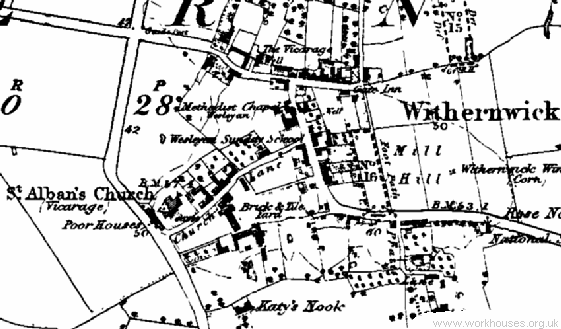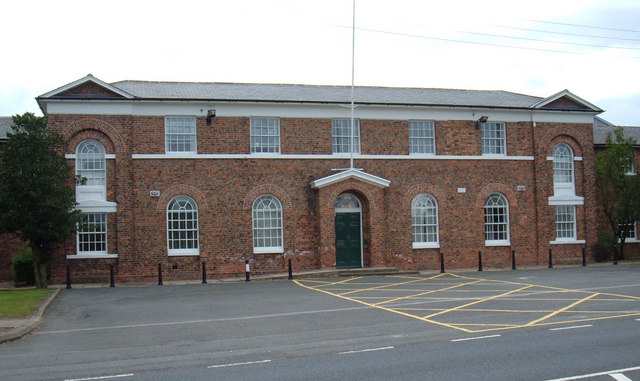It seems fairly obvious that most of the inhabitants of Withernwick in
the past were not wealthy. Most would have been farm labourers in what was
then a very labour intensive business. But no doubt there were some who
were poorer than the average and in those days there was no state run
social security system. However there were things to help the poorest
members of the village. No doubt the extended family would often help
those who came upon hard times. Failing that there were in the village
some poor houses. These seem to preceed the idea of a workhouse and were
provided by the community, the church or a wealthy benefactor. The poor
houses in the village were at the west end of St Alban's. They are shown
in a map of 1855.

|
There is no photograph to show this
but if you look carefully at an old print of St Alban's there does
seem to be a low roofline at the west end (i.e., the left hand side
of the photo as we look at it). Click here There is a patch of ground in front of the present wall at the west end of the church were these must have stood. It is not a very large patch of ground and so we can only assume from the evidence that the building(s) were low and narrow. We have no idea how these would have worked. |
 |
In 1837 the Skirlaugh Poor Law
Union was formed and in 1838/9 they built a workhouse on the main
road through Skirlaugh, which you will recognise as the present
council offices. To read more about the history of the Skirlaugh
Workhouse click here. At this time, those unfortunate to fall upon hard times for what ever reason would have spent time in this workhouse. Probably this would not just be due to financial difficulties but may well have been due to disabilty, old age or being an unmarried mother where no family was around to support the person. We will now have a look at several Withernwick people who ended up in the Skirlaugh Workhouse. We have no actual evidence for any of them as to why this happened, but we might make some educated guesses. |
1 - Mary Stoner - she was the daughter of William and Nancy Stoner of
Withernwick. She was born in 1828, by which time her father was 37 and her
mother 44. In 1851 the parents have disappeared and Mary is living in the
village with the Ashbridge family. The mother Elizabeth Ashbridge is
described as Mary's sister and Mary is described as a visitor (pauper). By
1871 Mary is in the Skirlaugh Workhouse but there are no details as to
why. However in 1881, Mary is still in the workhouse but is now described
as an 'imbecile', a very non-PC term in the modern world. But what it no
doubt tells us is that Mary was disabled in some way which had presumably
prevented her from working when she was younger. One might wonder as to
the effect of the age of her mother in those days. It is impossible to
know what the problem was, but by 1891 Mary was aged 51 which wasn't a bad
age for then. Simply, health care was poor and attitudes to
disability of many kinds would have been unsympathetic to say the least.
2 - The North family - In 1871, Fanny North and her three children,
Susannah, Martin and John were living in North End, Withernwick but no
father is mentioned. In 1881 all four of them are in Skirlaugh Workhouse
and Fanny is described as a 'domestic servant'. We can only guess in this
case, that this must have been a temporary state of affairs. By 1891 Fanny
(Frances) is back in Withernwick and described as a 'char woman', Martin
is a farm labourer with a Dixon family in Brandesburton, John is working,
also as a farm labourer, ith a Gibson family in Goxhill (Hatfield), and
Susannah is living with a Dunn family in Mappleton (the census doesn't
specify what she was doing there, but she was probably a domestic
servant of some kind).
3 - Hannah Simpson - In 1861 Hannah is living in Gate Lane (High
Street) Withernwick with her mother and father, Thomas and Ann. But there
is also John William who is obviously the son of Hannah. By 1871, Hannah
is in the Skirlaugh Workhouse but on her own, there seems to be no trace
of the rest of the family. She is 39 years old and one has to wonder why
she isn't working. After that there is no trace of her.
4 - William Robinson - In 1891, William is living with his mother Fanny
and is aged 23 (he was born in Withernwick in 1868, son of Fanny and John
Boynton Robinson). He is the brother of Henry Robinson (b 1850) who we
know quite a lot about - click here.
By 1901 William is in the workhouse and is described as a general
labourer. In 1911 he is still in the workhouse and described as 'formerly
a general labourer'. This is clearly quite a long time to be in the
workhouse and one wonders if this was due to some physical disabilty
caused by a accident. We can guess that accidents were quite common in the
days before 'health and safety' and there wouldn't have been 'disability
allowance' to help.
There seem to have been no other Withernwick residents who became inmates
of Skirlaugh Workhouse. We can be sure there was a lot of poverty,
certainly more than the four cases above in the village but maybe most
were helped by family and friends.
Return to Tales Return to History